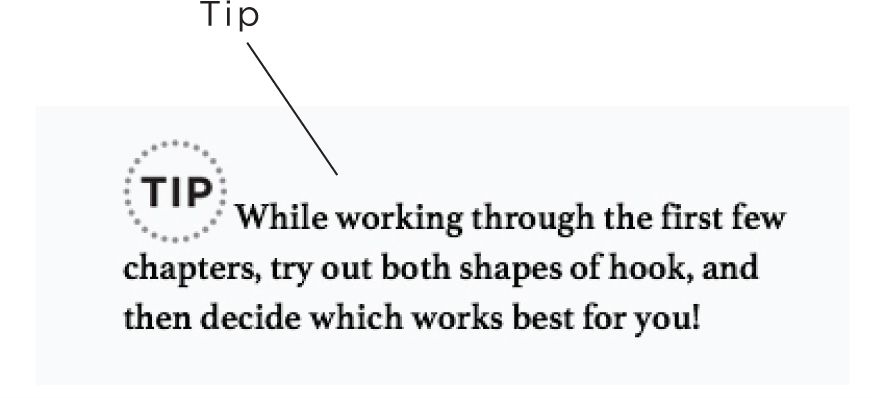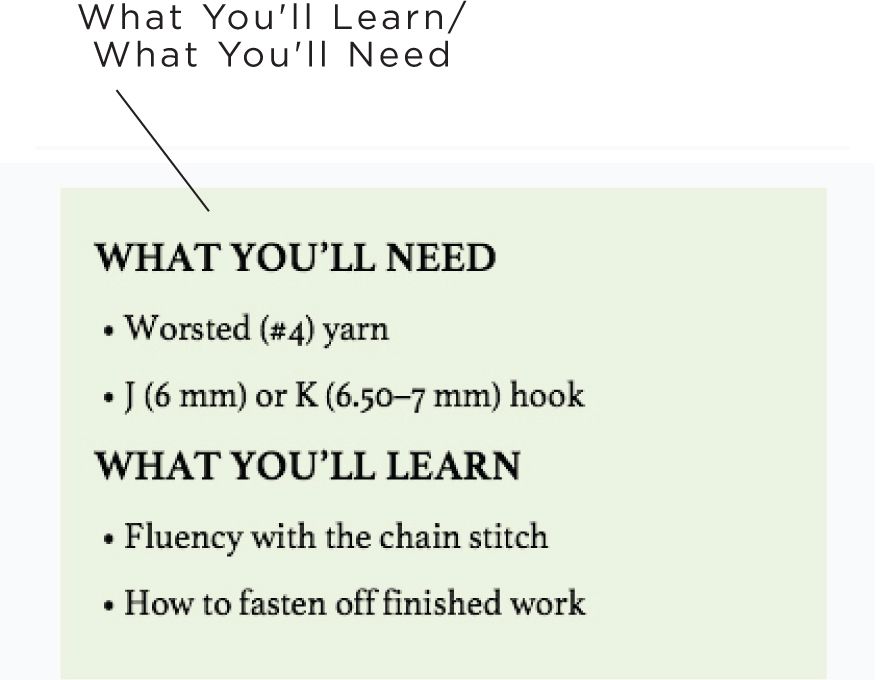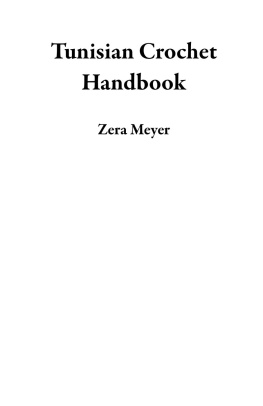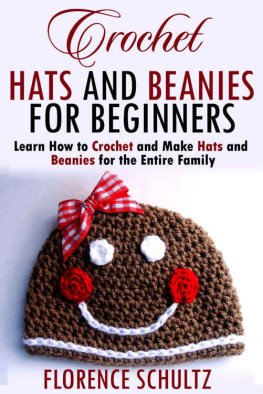

CONTENTS
Introduction
Welcome to the versatile, creative world of crochet! Crochet 101 is designed to help you learn painlessly, building each new skill on the success of those youve mastered, and to grow your confidence as each chapter enables you to create a beautiful and useful project. Easy-to-follow instructions with lots of colorful photographs help you gain crochet skills step-by-step. Along the way, youll create accessories, toys, garments, and home dcor items with great appeal!
A versatile fiber art, crochet can create softly draping fabric for shawls and sweaters, firm 3-dimensional stuffed toys and sculptures, sturdy or delicate fabrics according to need. With its limitless possibilities in form and function, crochet is enjoyed by millions of people of all ages and genders, worldwide. The universal stitch symbols youll learn in this book mean that patterns are shared across usual boundaries of language and culture, opening wide the doors to creative expression.
Each chapter of Crochet 101 introduces a new stitch or technique. Youll practice that skill, and then use it in making a beautiful project. The new skill or skills in each chapter are listed in the section labeled What Youll Learn. Supplies and materials for the lesson and its project are listed as What Youll Need. Troubleshooting boxes will help you evaluate the quality, possible mistakes, and means of correcting them, in your work as you progress. Quick Reference and Crochet Language boxes explain terms and processes without requiring you to turn to another page. Tips offer the sort of specific encouragement that builds confidence and ensures mastery. Each project specifies a particular yarn, but also includes suggestions for substitution. Projects can be made in the colors shown, or in your own favorites, and many projects also include suggestions for optional variationsways to further personalize your crochet.
The first section, Chapters 1-6 Crochet Basics, acquaints you with the tools, materials, and methods for making basic crochet stitches in rows and in the round. When these chapters and projects are completed, youll have achieved an Advanced Beginner skill level, and will find a world of possibilities open to you. The second section, Chapters 7-12 Putting It All Together, moves beyond the basics into the realm of textured and shaped fabric, pattern-stitches, and more complex sets of directions. The projects in this section include textural fabrics forming fitted accessories and garments. The final section, Chapters 13-16 Crochet Traditions, introduces some of the traditional styles of crochet: Thread Lace, Filet Crochet, and Tunisian Crochet; and offers tips and tricks to add excellence to finished projects and make construction easier. When the last project is completed, youll be a solid and confident Intermediate Crocheter, ready to independently learn any advanced or specialized technique that appeals to you. Youll be able to read and follow standard patterns and diagrams, or crochet creatively from your own ideas.
Start each chapter by reading through the What Youll Learn and What Youll Need boxes. Make sure the tools and materials for the lesson are at hand, so your learning and practice are not interrupted. Follow the written instructions and photographs, and dont skip the Practice Swatches. Practice pieces are not a waste of time; they add to your understanding of the skill, and train your hands in their new task, before beginning the project. Even Advanced and Expert crocheters begin new projects with practice swatches, so its a very good habit to start. Use the Troubleshooting boxes and Tips to evaluate and improve your stitching, and then youll be ready for the chapters project.



The video tutorials created to supplement this book are an additional learning tool demonstrating the essential techniques used in crochet. You can access the video at this web site: www.qbookshop.com/pages/crochet101.
Most of all, have fun with these crochet projects. Enjoy your own blossoming creativity as you learn new skills.
Crochet Basics

Theres no better place to start than at the very beginning. In writing this book, we assume youre starting from scratch, and we know that for a new crocheter, even a trip to the yarn shop or crafts store can be challenging. There is an almost overwhelming variety of pattern leaflets, yarns, crochet hooks, and notions to choose from. To give you a firm foundation for learning to crochet, this section starts with essential facts about hooks and yarns. Next, youll learn the basic stitches and the written language of crochet patterns. If crochet is completely new to you, youll appreciate the detailed information and photos. Even if you have some crochet experience, youll probably learn something new.
Its important to remember that youre training the muscles of your hands and fingers in movements new to them. Be patient with yourselfmuscle memory develops by repetition. The process of learning will be more enjoyable if you give yourself permission to be a beginner. Mistakes are a normal and natural part of the process. Holding and moving the hook and yarn will seem awkward at first; thats also part of the process. Relax! Stretch your shoulders and hands often; dont forget to breathe. Speed is not a measure of success, so feel free to stitch slowly, to take frequent breaks, and to enjoy the feeling of yarn passing through your fingers.
Lets explore the basics of crochet!
CHAPTER 1: Getting Started
The Tools
At its simplest, crochet can be done with no tools at all, using the fingers to pull loops of yarn through other loops. But over the years, crocheters have found that a specialized hook eases the work and makes it possible to create much more complex and beautiful stitches. Generally, the only current uses for finger crochet are keeping lengths of electrical cord from tangling and keeping children occupied when they must sit still. All real crochet involves a hook of one sort or another, so lets take a look at the crochet hook.
THE CROCHET HOOK
Hooks come in several different sizes and shapes, depending on their intended uses. But they all have the same parts, labeled in the photo below.
The tip of the hook is the part thats inserted between strands of yarn, and tips vary in shape from blunt to more pointed. The throat (or shank) and chin of the hook are the parts that do the actual work, catching a loop of yarn and pulling it through other loops. The shaft is what gives the hook its official size, and the size of the shaft determines the size of the loops made. Some hooks have a thumb rest and some dont. When present, the thumb rest can make it easier to hold the hook, and also to loosen loops that have become too tight. On some brands of hooks, the thumb rest has been expanded into an ergonomic handlecrocheters with arthritis, carpal tunnel syndrome, and other hand health issues find that these handles help to keep their crochet hobby possible and pain-free. Some hooks, especially those made of wood, have decorative turning or carving at the end of the shaft. This shaping can help to provide balance, but is mostly an aesthetic element.












